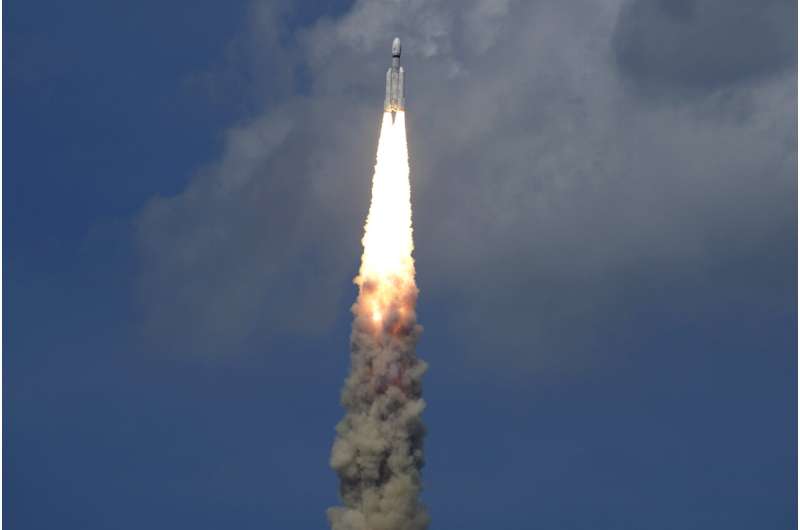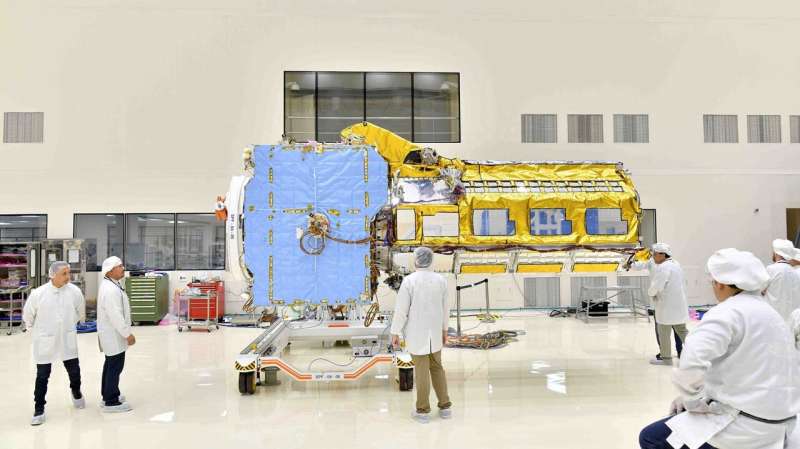Low altitude flights study everyday emissions
Sunday, 16 July 2023 10:36 Often research associated with air quality and pollution prioritizes transportation - especially car emissions - as an area of focus. However, many urban areas have less pollution from motor vehicles than in the past. That's why scientists leading the AEROMMA project this summer are focused on gathering data on other anthropogenic, or human-based, pollution sources.
The AEROMMA project - A
Often research associated with air quality and pollution prioritizes transportation - especially car emissions - as an area of focus. However, many urban areas have less pollution from motor vehicles than in the past. That's why scientists leading the AEROMMA project this summer are focused on gathering data on other anthropogenic, or human-based, pollution sources.
The AEROMMA project - A NASA-ISRO earth observing satellite coming together in India
Sunday, 16 July 2023 10:36 Built on opposite sides of the planet, the NISAR satellite will deepen understanding of climate change, deforestation, glacier melt, volcanoes, earthquakes, and more.
Two major components of the NISAR satellite have been combined to create a single spacecraft in Bengaluru, India. Set to launch in early 2024, NISAR - short for NASA-ISRO Synthetic Aperture Radar - is being jointly developed
Built on opposite sides of the planet, the NISAR satellite will deepen understanding of climate change, deforestation, glacier melt, volcanoes, earthquakes, and more.
Two major components of the NISAR satellite have been combined to create a single spacecraft in Bengaluru, India. Set to launch in early 2024, NISAR - short for NASA-ISRO Synthetic Aperture Radar - is being jointly developed NASA's GISTEMP Confirms June 2023 as the Record-Breaking Warmest Month
Sunday, 16 July 2023 10:36 NASA recently disclosed that June 2023 was the most thermally elevated June recorded in history. This information has emerged from NASA's meticulous global temperature analysis, conducted via its Goddard Institute for Space Studies (GISS), New York.
The GISTEMP, an acronym for NASA's Global Land-Ocean Temperature Index, has facilitated this groundbreaking finding. The process of GISTEMP is
NASA recently disclosed that June 2023 was the most thermally elevated June recorded in history. This information has emerged from NASA's meticulous global temperature analysis, conducted via its Goddard Institute for Space Studies (GISS), New York.
The GISTEMP, an acronym for NASA's Global Land-Ocean Temperature Index, has facilitated this groundbreaking finding. The process of GISTEMP is Industry offers wish list for commercial space legislation
Saturday, 15 July 2023 10:54
As the House Science Committee considers a commercial space bill, industry officials advocated for key topics they believe should be included in that legislation.
UK targets laser satellite communications with NorthumbriaU research grant
Saturday, 15 July 2023 09:32 Northumbria University in the UK is set to revolutionize the satellite communication systems, thanks to a generous funding award of 5 million pounds from the UK Space Agency. This investment will enable the university's researchers to pioneer the creation of a laser-based system that will significantly overhaul the current satellite communication methodologies.
Currently, satellites depend
Northumbria University in the UK is set to revolutionize the satellite communication systems, thanks to a generous funding award of 5 million pounds from the UK Space Agency. This investment will enable the university's researchers to pioneer the creation of a laser-based system that will significantly overhaul the current satellite communication methodologies.
Currently, satellites depend Plato's structural test campaign
Saturday, 15 July 2023 09:32 From May to August 2023 a structural model of ESA's next exoplanet mission, Plato, is undergoing a test campaign at ESA's ESTEC Test Centre, at Noordwijk in the Netherlands. Plato is planned to launch on an Ariane 6 in 2026. During lift-off Plato will have to withstand intense vibrations and immense blasts of noise. To make sure the satellite can survive the start of its journey to space, engine
From May to August 2023 a structural model of ESA's next exoplanet mission, Plato, is undergoing a test campaign at ESA's ESTEC Test Centre, at Noordwijk in the Netherlands. Plato is planned to launch on an Ariane 6 in 2026. During lift-off Plato will have to withstand intense vibrations and immense blasts of noise. To make sure the satellite can survive the start of its journey to space, engine NASA advances Orion modules for upcoming artemis missions
Saturday, 15 July 2023 09:32 It was an impressive sight inside the high bay of the Neil Armstrong Operations and Checkout Building at NASA's Kennedy Space Center in Florida. On June 22, 2023, a trio of Orion spacecraft destined for NASA's Artemis II, Artemis III, and Artemis IV missions stood adjacent to each other, each at a distinct stage of production. Engineers and technicians are diligently preparing these spacecraft t
It was an impressive sight inside the high bay of the Neil Armstrong Operations and Checkout Building at NASA's Kennedy Space Center in Florida. On June 22, 2023, a trio of Orion spacecraft destined for NASA's Artemis II, Artemis III, and Artemis IV missions stood adjacent to each other, each at a distinct stage of production. Engineers and technicians are diligently preparing these spacecraft t Artemis instruments to study volcanic terrain on the Moon
Saturday, 15 July 2023 09:32 As part of NASA's regular cadence of robotic lunar missions through Artemis, the agency has selected a new scientific payload to establish the age and composition of hilly terrain created by volcanic activity on the near side of the Moon.
The DIMPLE instrument suite, short for Dating an Irregular Mare Patch with a Lunar Explorer, will investigate the Ina Irregular Mare Patch, discovered in
As part of NASA's regular cadence of robotic lunar missions through Artemis, the agency has selected a new scientific payload to establish the age and composition of hilly terrain created by volcanic activity on the near side of the Moon.
The DIMPLE instrument suite, short for Dating an Irregular Mare Patch with a Lunar Explorer, will investigate the Ina Irregular Mare Patch, discovered in Virgin Galactic Unveils Plans for its Second Commercial Spaceflight, Galactic 02
Saturday, 15 July 2023 09:32 Virgin Galactic Holdings, Inc. (NYSE: SPCE) has released details about the forthcoming flight window for its second commercial space mission, christened 'Galactic 02.' The new announcement positions Virgin Galactic firmly within an expanding commercial space industry and highlights its regular rhythm of spaceflights.
The company's pioneering approach has led to a remarkable seventh spacefl
Virgin Galactic Holdings, Inc. (NYSE: SPCE) has released details about the forthcoming flight window for its second commercial space mission, christened 'Galactic 02.' The new announcement positions Virgin Galactic firmly within an expanding commercial space industry and highlights its regular rhythm of spaceflights.
The company's pioneering approach has led to a remarkable seventh spacefl Above Space signs Umbrella Space Act Agreement With NASA
Saturday, 15 July 2023 09:32 Above Space Development Corporation, a key player in the space technology sector, has recently inked an Umbrella Space Act Agreement (SAA) with NASA, a development set to have significant implications for both parties. This five-year SAA outlines the scope for collaborative work on various technologies designed for commercial, civil, and government clientele, marking an important step in the pro
Above Space Development Corporation, a key player in the space technology sector, has recently inked an Umbrella Space Act Agreement (SAA) with NASA, a development set to have significant implications for both parties. This five-year SAA outlines the scope for collaborative work on various technologies designed for commercial, civil, and government clientele, marking an important step in the pro India launches Chandrayaan-3 mission on path toward moon landing
Saturday, 15 July 2023 09:32 India will try to become the fourth country to land on the moon after its Chandrayaan-3 spacecraft left Earth in a liftoff on Friday.
The Mark-3 rocket with Chandrayaan-3 on top blasted off shortly after 5 a.m. EDT from the Satish Dhawan Space Center on the coastal island of Sriharikota.
"Chandrayaan-3, in its precise orbit, has begun its journey to the moon. Health of the spacec
India will try to become the fourth country to land on the moon after its Chandrayaan-3 spacecraft left Earth in a liftoff on Friday.
The Mark-3 rocket with Chandrayaan-3 on top blasted off shortly after 5 a.m. EDT from the Satish Dhawan Space Center on the coastal island of Sriharikota.
"Chandrayaan-3, in its precise orbit, has begun its journey to the moon. Health of the spacec Space Force to select three providers of national security launch services
Friday, 14 July 2023 19:09
The U.S. Space Force released a revised draft solicitation for the next round of national security launch contracts, known as National Security Space Launch Phase 3.
Crowds cheer as India launches a lander and rover to explore the moon's south pole
Friday, 14 July 2023 17:08
Examining our options for a lunar solar power satellite
Friday, 14 July 2023 17:00
The concept of gathering some of the unlimited sunlight available in space, then transmitting it down to users, was first developed to serve the clean energy needs of planet Earth. But Space-Based Solar Power can also work for the moon.
As part of ESA's Open Space Innovation Platform Campaign on 'Clean Energy—New Ideas for Solar Power from Space', a study undertaken by Switzerland's Astrostrom company designed a Greater Earth Lunar Power Station, or GE⊕-LPS for short.
The study envisages a solar powersatellite constructed mainly from lunar resources (including moon-manufactured solar cells) that could deliver megawatts of microwave power down to receivers on the lunar surface, serving the needs of surface activities, including future crewed bases.
Taking inspiration from a butterfly, GE⊕-LPS feature V-shaped solar panels with integrated antennas, deployed in a helix configuration extending more than a square kilometer end to end. The design would yield continuous 23 megawatts of energy for lunar surface operations. The solar panels themselves are based on iron pyrite monograin-layer solar cells produced on the moon.
Located at an Earth-moon Lagrange point around 61 350 km from the lunar surface, the station itself would also be inhabited.
Powerful NASA-ISRO Earth-observing satellite coming together in India
Friday, 14 July 2023 15:12
Built on opposite sides of the planet, the NISAR satellite will deepen our understanding of climate change, deforestation, glacier melt, volcanoes, earthquakes, and more.
Two major components of the NISAR satellite have been combined to create a single spacecraft in Bengaluru, India.

